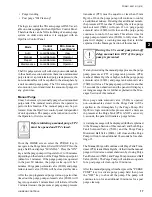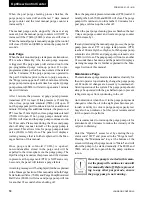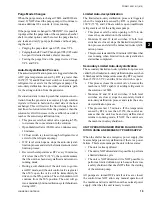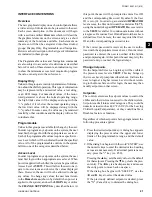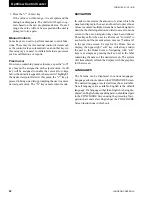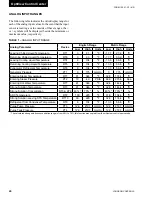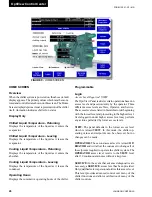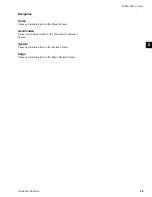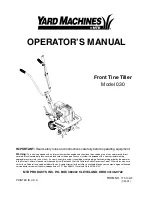
JOHNSON CONTROLS
14
FORM 155.21-O1 (615)
OptiView Control Center
Dilution Cycle Operation
A dilution cycle is performed every time the chiller is
cycled off or shutdown. The purpose of the dilution cycle
is to prevent the solution from crystallization while the
chiller is off by reducing the solution concentration.
The goal is to reduce the concentration down to 57°
(13.8°C) at which the crystallization temperature is
near 35° F (1.6°C). A dilution cycle will occur at most
unit shutdowns. A typical dilution cycle will operate the
refrigerant, solution, generator (Franklin pumps 10E3 –
14F3 only), condenser and chilled liquid pumps with the
control valve fully closed. When a dilution cycle is per-
formed, the evaporator continues generating vapor and
the absorber continues the mass transfer by absorbing the
vapor, but the rate produced in the generator is reduced
drastically because the control valve is closed.
The Mod “D”, YIA absorption chiller is capable of
performing four different dilution cycles:
1. Normal dilution
2. Manual dilution
3. Limited dilution
4. Short dilution
Normal Dilution Cycle
– is performed when the short
dilution cycle is disabled and unit is under either leaving
chilled liquid temp (LCHLT) control or strong solution
concentration (SSC) control. The control valve will close
and all pumps; solution, refrigerant, generator (Franklin
pumps 10E3 – 14F3 units only), condenser and chilled
liquid will continue to run for 6 minutes. The normal
dilution cycle will terminate after the 6 minute interval is
complete. A normal dilution cycle is independent of the
solution concentration at the start of the dilution cycle.
A normal dilution cycle will initiate in all three control
panel access levels (View, Operator, or Service). The
following conditions will pre-maturely terminate the
normal dilution cycle.
During normal operation where at least medium load
prevails, Lithium Bromide in the refrigerant circuit is
NOT required. The YIA unit provides means for Lithium
Bromide removal from the refrigerant circuit as load is
increased.
During operation, the refrigerant temperature sensor
(RT8), which is continuously monitored and displayed,
provides several control functions. If the refrigerant
temperature falls to 35.5°F (1.9°C), the stabilizer refriger-
ant solenoid valve (2SOL) is energized (open) on units
equipped with Franklin pumps; if the unit is equipped with
Buffalo pumps, it will be energized only if the refrigerant
pump is running. This transfers refrigerant to the genera-
tor’s solution outlet line to reduce the concentration, thus
reducing the cooling capacity of the unit. This lessens the
possibility of crystallization. Simultaneously, unit loading
is inhibited to 50% valve position. If the temperature falls
to 34.0°F (1.1°C), the solution (absorber on 50 Hz Models
YIA-10E3 – YIA-14F3 with Franklin pumps) pump turns
off; this should allow the refrigerant temperature to rise.
If the refrigerant temperature rises to 35.5°F (1.9°C), the
solution pump turns on. If the refrigerant temperature
rises to 36.0°F (2.2°C), the stabilizer refrigerant solenoid
valve is de-energized (closed), and the unit loading inhibit
is removed.
However if the refrigerant temperature continues to fall,
a low refrigerant temperature safety shutdown occurs at
33.0°F (.5°C). If the unit experiences a shutdown when
the refrigerant temperature is 34°F (1.1°C) or below, the
chilled liquid pump contacts remain closed for a mini-
mum of 30 minutes. Subsequently, when the refrigerant
temperature rises to 37.0°F (2.8°C), the dilution cycle
begins.
The motor coolant solenoid valve (units with Franklin
pumps only) is energized (open) whenever the strong solu-
tion temperature is above 160°F (71.1°C) (this threshold
is programmable from 127°F to 160°F (52.8 to 71.1°C);
the threshold should only be programmed by a qualified
service technician.
The motor coolant solenoid valve is de-energized (closed)
whenever the strong solution temperature is below the
programmed open threshold minus 10°F. The purpose
of the valve is to prevent evaporation of water from the
coolant reservoir during unit shutdown or when the unit
operates at low load and low condensing water tempera-
tures. However, if the refrigerant and solution (absorber
and generator on 50 Hz Models YIA-10E3 – YIA-14F3
with Franklin pumps) pump motor coolant level float
switch opens, the unit locks out on a safety shutdown.

















